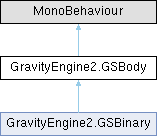 |
Gravity Engine 2 8.0
|
 |
Gravity Engine 2 8.0
|
A component for the in-scene representation of a body to be evolved with GE via a GravitySceneController. More...

Public Member Functions | |
| GSBinary | Binary () |
| If this body is a member of a GSBinary then the GSBinary object will have the details on the joint orbit and the mass fractions etc. | |
| void | BinarySet (GSBinary gsBinary) |
| GSBody | CenterBody () |
| Orbital.COE | COEFromBID () |
| int | Id () |
| void | IdSet (int id) |
| override string | ToString () |
Public Attributes | |
| BodyInitData | bodyInitData = new BodyInitData() |
| GSBody | centerBody |
| string | ephemFilename |
| bool | ephemRelative |
| double | mass |
| bool | optionalDataFoldout |
| bool | patched |
| GEPhysicsCore.Propagator | propagator = GEPhysicsCore.Propagator.GRAVITY |
| double | radius |
| Vector3 | rotationAxis = Vector3.up |
| double | rotationPhi0 = 0.0 |
| double | rotationRate = 0.0 |
Static Public Attributes | |
| static int | NO_ID = -1 |
| GravityData id. Assigned when added to GE. | |
A component for the in-scene representation of a body to be evolved with GE via a GravitySceneController.
The initial state of the body can be represented in a number of ways: 1) Absolute position/velocity in world space 2) Relative position/velocity with respect to another GSBody 3) In orbit relative to a center body. The orbit is specified via the "classical orbital elements (COE)" or variations (where e.g. apoapsis and periapsis can be used instead of major axis and ecentricity. Note apoapsis is the general form of apogee, which is for the Earth) 4) In orbit around the Earth via the Spacetrack two line element format. This is a commonly used general format specifying the orbit parameters and epoch time. It can be retreived from e.g. Celestrak
The GSBody component also allows the specification of how GE will propagate the body. The general case is to use N-body evolution (GRAVITY). Other choices are: FIXED: don't move it at all (suitable for e.g. a central star) KEPLER: Keep object "on-rails" around a center body and evolve with Kepler's equation SGP4: Move according to a model that incorporates Earth oblateness, atmospheric drag, Moon, Sun. This is only valid for a center body that is modelling the Earth. PKEPLER: An Earth orbit model that incorporates non-spherical Earth only (e.g. for Sun synchronous orbits. These rely on the non-spherical orbit perturbation. Only valid for Earth orbits.